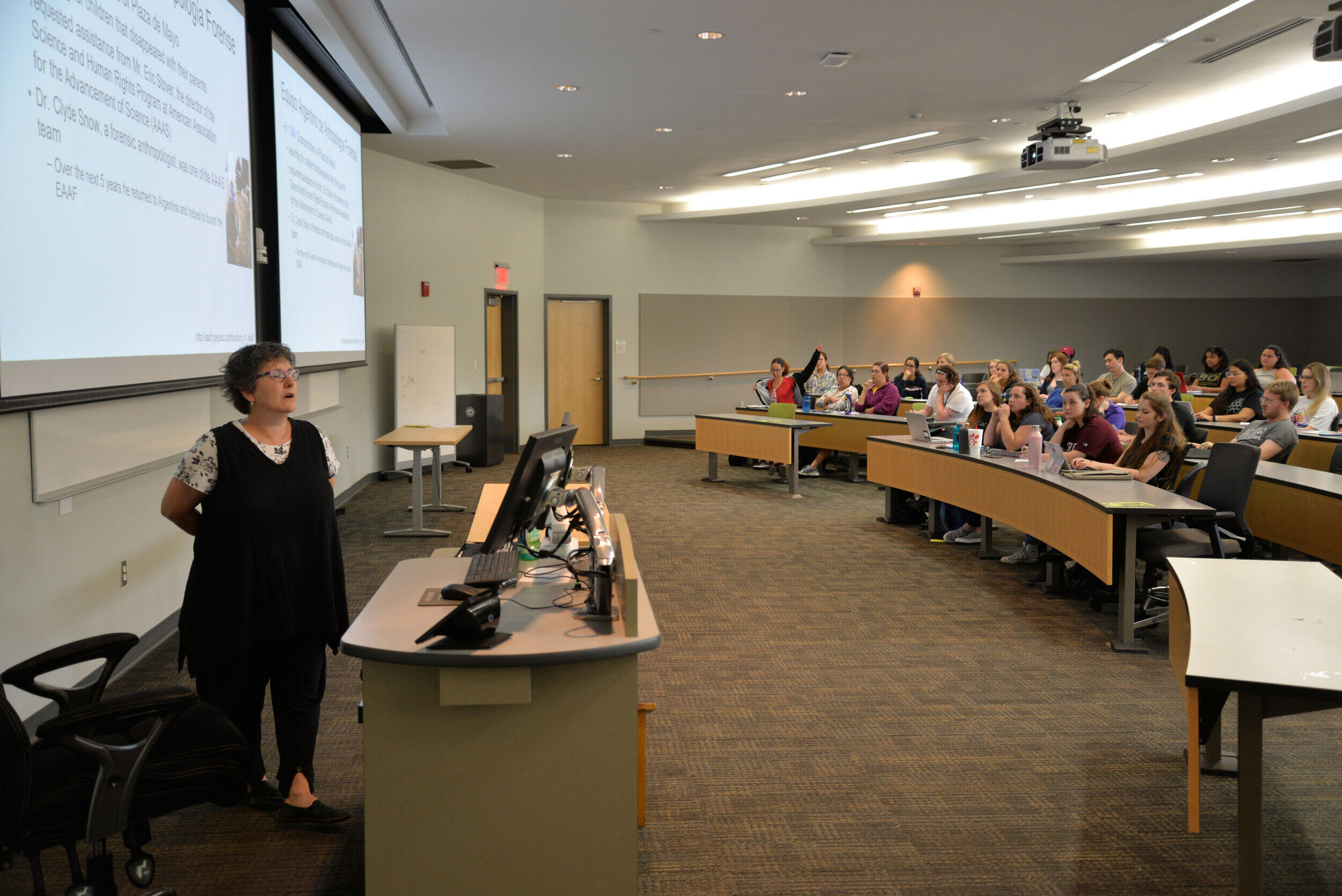
Aug. 30, 2019
Forensic science lecture series explores emerging research and high-profile cases
Share this story
A series of forensic science lectures this fall will explore topics in the field and past cases, including the so-called “collar bomb” case in which a pizza delivery driver in Erie, Pennsylvania, robbed a bank in 2003 with a bomb clamped around his neck that ultimately exploded and killed him.
The weekly lecture series hosted by the Department of Forensic Science in the College of Humanities and Sciences is held Wednesdays, from 2 to 3 p.m. in Room 2201 of the Academic Learning Commons, 1000 Floyd Ave. The talks are free and open to the public.
The lectures bring in leading external forensic scientists, highlight forensic science research being conducted at Virginia Commonwealth University and elsewhere, and expose VCU forensic science students to disciplines that may be outside the scope of their coursework.
The series got underway last week with a lecture by Tal Simmons, Ph.D., a VCU forensic science professor, who spoke on “Forensic Anthropology in the Service of Human Rights.” Simmons, who is also organizing the lecture series, is an expert in forensic anthropology and has applied forensic science to human rights violation investigations in numerous cases, including in Bosnia, Sri Lanka, Kosovo and elsewhere.
On Sept. 4, Kelli Lewis, laboratory director of the Forensic Science Division of the U.S. Secret Service, will give a talk on the agency’s forensic capabilities. Later in the semester, on Nov. 13, Alice R. Isenberg, Ph.D., deputy assistant director of the FBI Laboratory, will speak on the effects of stress and vicarious trauma in a forensic environment.
“Forensic science practitioners working in forensic laboratories, medical examiner/coroner offices, and crime scene units face a unique array of stressors on a daily basis,” according to the description of Isenberg’s talk. “These include high workloads and demanding deadlines, expectations of error-free work, testimony in court, exposure to traumatic crime scene material, interactions with victims and families, and exposure to graphic digital material. Exposure to traumatic material and the traumatic experiences of other people — known as vicarious trauma — is an inevitable occupational challenge for these fields. This presentation will educate participants about vicarious trauma and outline strategies for individuals and organizations to increase resilience to exposure to stressors in a forensic environment.”
The “collar bomb” case will be the subject of a talk Sept. 18 by Carlo Rosati, a retired FBI forensic examiner in firearms and tool marks. The case was the subject of a 2018 true crime Netflix four-part series called “Evil Genius: The True Story of America’s Most Diabolical Bank Heist.”
The full schedule of forensic science lectures is:
Sept. 4
“Forensic Capabilities of the U.S. Secret Service”
Kelli Lewis, laboratory director, U.S. Secret Service Forensic Science Division
Sept. 11
“From Biblical Plagues to Extraterrestrial Life and Microbial Forensics: Near Misses in Applied Research”
Christopher Ehrhardt, Ph.D., associate professor in the VCU Department of Forensic Science
Sept. 18
“Forensic Case Studies: Collar Bomb”
Carlo Rosati, FBI (retired)
Sept. 25
“Comprehensive Toxicology Screening Using High Resolution Mass Spectrometry”
Rebecca Wagner, Ph.D., research section supervisor, Virginia Department of Forensic Science
Oct. 2
“Data Dive: Digital Forensics through Case Studies”
Nicole Odom, forensic scientist, Digital & Multimedia Evidence Section, Virginia Department of Forensic Science — Central Laboratory
Oct. 9
“Locard's Principle in a Digital Era: No Data Left Behind”
Patrick Eller, CEO, Metadata Forensics LLC
Oct. 16
“Forensic Video Analysis — Capabilities, Case Studies, and Law”
Patricia Reiber, forensic scientist senior, Digital & Multimedia Evidence Section, Virginia Department of Forensic Science - Central Laboratory
Oct. 23
“Explosive Residue Transfer from Various Explosive Ordinance Disposal (EOD) Render Safe Procedures (RSPs)”
Joseph Stein, graduate student in VCU’s M.S. Forensic Science program
Oct. 30
“Application of Optical Tweezers for Cell Separation of Forensic Evidence”
Sarah Williams, Ph.D., assistant professor in the VCU Department of Forensic Science
Nov. 6
“Medical Legal Illustration as Demonstrative Evidence in Medical Malpractice, Personal Injury, and Wrongful Death Cases”
Marie Dauenheimer, medical illustrator, Compel Visuals
Nov. 13
“Effects of Stress and Vicarious Trauma in a Forensic Environment”
Alice Isenberg, Ph.D., FBI deputy assistant director, Laboratory Division
Nov. 20
“Effective Laundering Conditions for Ignitable Liquid Decontamination of Fire Scene Clothing Used by the Bureau of Alcohol, Tobacco, Firearms and Explosives”
Rebecca Whitney, graduate student in VCU’s M.S. Forensic Science program
Dec. 4
“Development of a Quantitative PCR (qPCR) Based Method for Studying Temporal DNA Degradation in Waterlogged Bone”
Isis Thornton, graduate student in VCU’s M.S. Forensic Science program
Subscribe to VCU News
Subscribe to VCU News at newsletter.vcu.edu and receive a selection of stories, videos, photos, news clips and event listings in your inbox.





